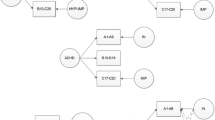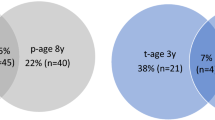Abstract
The agreement between teachers’ and parents’ ratings of the prevalence of DSM-IV attention deficit hyperactivity disorder (ADHD) symptoms and the concordance of the factor structure of ADHD symptoms was analyzed in a sample of 653 Spanish schoolchildren aged 4 to 12 divided into two age groups. The prevalence of ADHD symptoms ranged between 0.66 and 16.73% and was higher when the rater was the teacher. Agreement between parents and teachers was low. Confirmatory factor analysis (CFA) shows a slightly better fit for the three-factor model (Inattention, Hyperactivity and Impulsivity) than for the two-factor model (Inattention and Hyperactivity–impulsivity), except for parents’ ratings in the sample of children under six. CFA using a multitrait–multimethod model (CFA-MTMM) shows similar results.
Similar content being viewed by others
References
Achenbach, T. M., McConaughy, S. H., & Howell, C. T. (1987). Child/adolescent behavioral and emotional problems implications of cross-informant correlations for situational specificity. Psychological Bulletin, 101, 213–232.
Amador, J. A., Forns, M., & Martorell, B. (2001). Trastorno por déficit de atención con hiperactividad: Análisis evolutivo y consistencia entre informantes. [Symptoms of inattention and hyperactivity–impulsivity: Developmental analysis and inter-informant consistency.] Anuario de Psicología, 3 (1), 51–66.
Amador, J. A., Forns, M., Martorell, B., Guàrdia, J., & Peró, M. (2004). Confirmatory factor analysis of parent and teacher ratings of DSM-IV attention deficit hyperactivity disorder symptoms, is still in review process.
American Psychiatric Association (1980). Diagnostic and statistical manual of mental disorders (3rd ed.). Washington, DC: Author.
American Psychiatric Association (1987). Diagnostic and statistical manual of mental disorders (3rd ed., revised). Washington, DC: Author.
American Psychiatric Association (1994). Diagnostic and Statistical Manual of Mental Disorders (4th ed.). Washington, DC: Author.
American Psychiatric Association (2000). Diagnostic and Statistical Manual of Mental Disorders: DSM-IV-TR (text revision) Washington, DC: Author.
Antrop, I., Roeyers, H., Oosterlaan, J., & Van Oost, P. (2002). Agreement between parent and teacher ratings of disruptive behavior disorder in children with clinically diagnosed ADHD. Journal of Psychopathology and Behavioral Assessment, 24, 67–73.
Barkley, R. A. (1998). Attention deficit hyperactivity disorder: A handbook for diagnosis and treatment (2nd ed.). New York: Guilford.
Barkley, R. A., Fischer, M., Edelbrock, C. S., & Smallish, L. (1990). The adolescent outcome of hyperactive children diagnosed by research criteria: I. An 8-year prospective follow-up study. Journal of the American Academy of Child and Adolescent Psychiatry, 29, 546–557.
Baumgaertel, A., Wolraich, M. L., & Dietrich, M. (1995). Comparison of diagnostic criteria for attention-deficit disorder in a German elementary school sample. Journal of the American Academy of Child and Adolescent Psychiatry, 34, 629–638.
Beisser, M., Dion, R., & Gotowiec, A. (2000). The structure of attention-deficit and hyperactivity symptoms amog native and non-native elementary school children. Journal of Abnormal Child Psychology, 28, 435–437.
Bentler, P. (1995). EQS v5.7. Manual. Chicago: University Press.
Bentler, P. M., & Dijkstra, T. (1985). Efficient estimation via linearization in structural models. In P.R. Krishnaiah (Ed.). Multivariate Analysis VI (pp. 9–42). Amsterdam: North-Holland.
Biederman, J., Faraone, S. V., Milberger, S., & Boyle, A. (1993). Diagnosis of attention-deficit hyperactivity disorder from parent reports predicts diagnosis based on teacher reports. Journal of the American Academy of Child and Adolescent Psychiatry, 32, 315–317.
Boyle, M. H., Offord, D. R., Racine, Y. A., Szatmari, P., Sanford, M., & Fleming, J. E. (1997). Adequacy of interviews vs checklists for classifying childhood psychiatric disorder based on parent reports. Archives of General Psychiatry, 54, 793–799.
Brito, G. N. O., Pinto, R. C. A., & Lins, M. F. C. (1995). A behavioral assessment scale for attention deficit disorder in Brazilian children based on DSM-III-R criteria. Journal of Abnormal Child Psychology, 23, 509–520.
Burns, L. G., Boe, B., Walsh, J. A., Sommers-Flanagan, R., & Teegarden, L. A. (2001). A confirmatory factor analysis on the DSM-IV ADHD and ODD symptoms: What is the best model for the organization of these symptoms? Journal of Abnormal Child Psychology, 29, 339–349.
Burns, L. G., Walsh, J. A., & Gomez, R. (2003). Convergent and discriminant validity of trait and source effects in ADHD-inattention and hyperactivity/impulsivity measures across a 3-month interval. Journal of Abnormal Child Psychology, 31, 529–541.
Clarke, G. N., Lewinsohn, P. M., Hops, H., & Seeley, J. R. (1992). A self-and parent-report measure of adolescent depression: The Child Behavioral Checklist Depression Scale (CBCL-D). Behavioral Assessment, 14, 443–463.
Collet, B. R., Crowley, S. L., Gimpel, G. A., & Greenson, J. N. (2000). The factor structure of DSM-IV attention deficit-hyperactivity symptoms: A confirmatory factor analysis of the ADHD-SRS. Journal of Psychoeducational Assessment, 18, 361–373.
Crystal, D. S., Ostrander, R., San Chen, R., & August, G. J. (2001). Multimethod assessment of psychopathology among DSM-IV subtypes of children with attention-deficit/hyperactivity disorder: Self-, parent, and teacher reports. Journal of Abnormal Child Psychology, 29, 189–205.
Danforth, J. S., & DuPaul, G. J. (1996). Interrater reliability of teacher rating scales for children with attention-deficit hyperactivity disorder. Journal of Psychopathology and Behavioral Assessment, 18, 227–237.
DuPaul, G. J., Anastopoulos, A. D., Power, T. J., Reid, R., Ikeda, M. J., & McGoey, K. E. (1998). Parent rating of attenttion deficit hyperactivity disorder symptoms: Factor structure and normative data. Journal of Psychopathology and Behavioral Assessment, 20, 83–102.
DuPaul, G. J., Power, T. J., Anastopoulos, A. D., Reid, R., McGoey, K. E., & Ikeda, M. J. (1997). Teacher rating of attenttion deficit hyperactivity disorder symptoms: Factor structure and normative data. Psychological Assessment, 9, 436–443.
Eid, M. (2000). A multritrait-multimethod model with minimal assumptions. Psychometrika, 65, 241–261.
Fabre, T. R., & Walker, H. M. (1987). Teacher perceptions of the behavioral adjustment of primary grade level handicapped pupils within regular and special education settings. Remedial and Special Education, 8, 34–39.
Fischer, M., Barkley, R. A., Fletcher, K. E., & Smallish, L. T. (1993). The stability of dimensions of behavior in ADHD and normal children over an 8-year followup. Journal of Abnormal Child Psychology, 21, 315–337.
Gadow, K. D., Sprafkin, J., & Nolan, E. (2001). DSM-IV symptoms in community and clinic preschool children. Journal of the American Academy of Child and Adolescent Psychiatry, 40, 1383–1392.
Gimpel, G. A., & Kuhn, B. R. (2000). Maternal report of attention deficit hyperactivity disorder symptoms in preschool children. Child: Care, Health and Development, 26, 163–176.
Gomez, R., Burns, G. L., Walsh, J. A., & Alves de Moura, M. (2003). A multitrait-multisource confirmatory factor analytic approach to the construct validity of ADHD rating scales. Psychological Assessment, 15, 3–16.
Gomez, R., Harvey, J., Quick, C., Scharer, I., & Harris, G. (1999). DSM-IV AD/HD: Confirmatory factor models, prevalence, and gender and age differences based on parent and teacher ratings of Australian primary school children. Journal of Child Psychology and Psychiatry, 40, 265–274.
Hinshaw, S. P., Han, S. S., Erhardt, D., & Huber, A. (1992). Internalizing and externalizing behavior problems in preschool children: Correspondence among parent and teachers rating and behavior observation. Journal of Clinical Child Psychology, 21, 143–150.
Hollingshead, A. B. (1975). Four-factor Index of Social Status. New Haven, CT: Yale University Press.
Hu, L., & Bentler, P. M. (1999). Cutoff criteria for fit indexes in covariance structure analysis: Conventional criteria versus new alternatives. Structural Equation Modeling, 6, 1–55.
Keenan, K., & Wakschlag, L. S. (2000). More than the terrible twos: The nature and severity of behaviour problems in clinic-referred preschool children. Journal of Abnormal Child Psychology, 28, 33–46.
Lee, L., & Poon, L. (1994). Structural equation models. EQS Guide. CA.: University of Los Angeles Press.
Mandal, R. L., Olmi, D. J., & Wilczynski, S. M. (1999). Behavior rating scales: Concordance between multiple informants in the diagnosis of attention-deficit/hyperactivity disorder. Journal of Attention Disorders, 3, 97–103.
Mitsis, E. M., McKay, K. E., Schulz, K. P., Newcorn, J. H., & Halperin, J. M. (2000). Parent–teacher concordance for DSM-IV attention deficit/hyperactivity disorder in a clinic-referred sample. Journal of the American Academy of Child and Adolescent Psychiatry, 39, 308–313.
Molina, B. S. G., Smith, B. H., & Pelham, W. E. (2001). Factor structure and criterion validity of secondary school teacher ratings of ADHD and ODD. Journal of Abnormal Child Psychology, 29, 71–82.
Nolan, E., Gadow, K., & Sprafkin, J. (2001). Teacher reports of DSM-IV ADHD, ODD, and CD symptoms in schoolchildren. Journal of the American Academy of Child and Adolescent Psychiatry, 40, 241–249.
Pineda, D., Ardila, A., Roselli, M., Arias, B. F., Henao, G. C., Gomez, L. F., Mejia, S. E., & Miranda (1999). Prevalence of attention-deficit/hyperactivity disorder symptoms in 4- to 17-year-old children in the general population. Journal of Abnormal Child Psychology, 27, 455–462.
Rapoport, J. L., Donnelly, M., Zametkin, A., & Carrougher, J. (1986). Situational hyperactivity in a US clinical setting. Journal of Child Psychology and Psychiatry, 27, 639–646.
Reich, W., & Welner, Z. (1990). Diagnostic Interview for Children and Adolescent-Revised, Parent Version. St Louis, MO, Washington University, Division of Child Psychiatry.
Reig, R., & Maag, J. W. (1994). How many fidgets in a pretty much: A critique of behaviour ratings scales for identifying students with ADHD. Journal of School Psychology, 32, 339–354.
Rohde, L., Barbosa, G., Polancyk, G., Eizirik, M., Rasmussen, E. R., Neuman, R. J., & Todd, R. D. (2001). Factor and latent class analysis of DSM-IV ADHD symptoms in a school sample of Brazilian adolescents. Journal of the American Academy of Child and Adolescent Psychiatry, 40, 711–718.
Safran, J. S., & Safran, S. P. (1987). Teacher’s judgements of problem behavior. Exceptional Children, 54, 240–244.
Scahill, L., & Schwab-Stone, M. (2000). Epidemiology of ADHD in school-age children. Child and Adolescent Psychiatric Clinics of North America, 9, 541–555.
Schachar, R., Rutter, M., & Smith, A. (1981). The characteristics of situationally and pervasively hyperactive children: Implications for syndrome definition. Journal of Child Psychology and Psychiatry, 22, 375–392.
Shaffer, D., Fisher, P., Dulcan, M. K., & Davies, M. (1996). The NIMH Diagnostic Interview Schedule for Children Version 2.3 (DISC-2.3): Description, acceptability, prevalence rates, and performance in the MECA study. Journal of the American Academy of Child and Adolescent Psychiatry, 35, 865–877.
Sheskin, D. J. (2000). Handbook of parametric and nonparametric statistical procedures. (2nd ed.). FL: Chapman & Hall/CRC.
Stein, M. T. (2004). When parents and teachers disagree about a child’s behaviour: An opportunity for further evaluations. Journal of Developmental and Behavioral Pediatrics, 25, 50–51.
Tucker, L. R., & Lewis, C. (1973). A reliability coefficient for maximum likelihood factor analysis. Psychometrika, 32, 1–10.
Verhulst, F. C., van der Ende, J., Ferdinand, R., & Kasius, M. C. (1997). The prevalence of DSM-III-R diagnoses in a national sample of Dutch adolescents. Archives of General Psychiatry, 54, 329–336.
Weiss, M., Hechtman, L., & Weiss, G. (2000). ADHD in parents. Journal of the American Academy of Child and Adolescent Psychiatry, 39, 1059–1061.
Wolraich, M. L., Hannah, J. N., Baumgaertel, A., & Feurer, I. D. (1998) Examination of DSM-IV criteria for attention deficit hyperactivity disorder in a county-wide sample. Journal of Developmental and Behavioral Pediatrics, 19, 162–168.
Wolraich, M. L., Lambert, E. W., Baumgaertel, A., García-Tornel, S., Feurer, I. D., Bickman, L., & Doffing, M. A. (2003). Teachers’ screening for attention deficit/hyperactivity disorder: Comparing multinational samples on teacher rating of ADHD. Journal of Abnormal Child Psychology, 31, 445–455.
Wolraich, M. L., Lambert, E. W., Bickman, L., Simmons, T., Doffing, M. A., & Worley, K. A. (2004). Assessing the impact of parent and teacher agreement on diagnosing attention-deficit hyperactivity disorder. Journal of Developmental and Behavioral Pediatrics, 25, 41–47.
Author information
Authors and Affiliations
Corresponding author
Rights and permissions
About this article
Cite this article
Amador-Campos, J.A., Forns-Santacana, M., Guàrdia-Olmos, J. et al. DSM-IV Attention Deficit Hyperactivity Disorder Symptoms: Agreement Between Informants in Prevalence and Factor Structure at Different Ages. J Psychopathol Behav Assess 28, 23–32 (2006). https://doi.org/10.1007/s10862-006-4538-x
Accepted:
Issue Date:
DOI: https://doi.org/10.1007/s10862-006-4538-x




